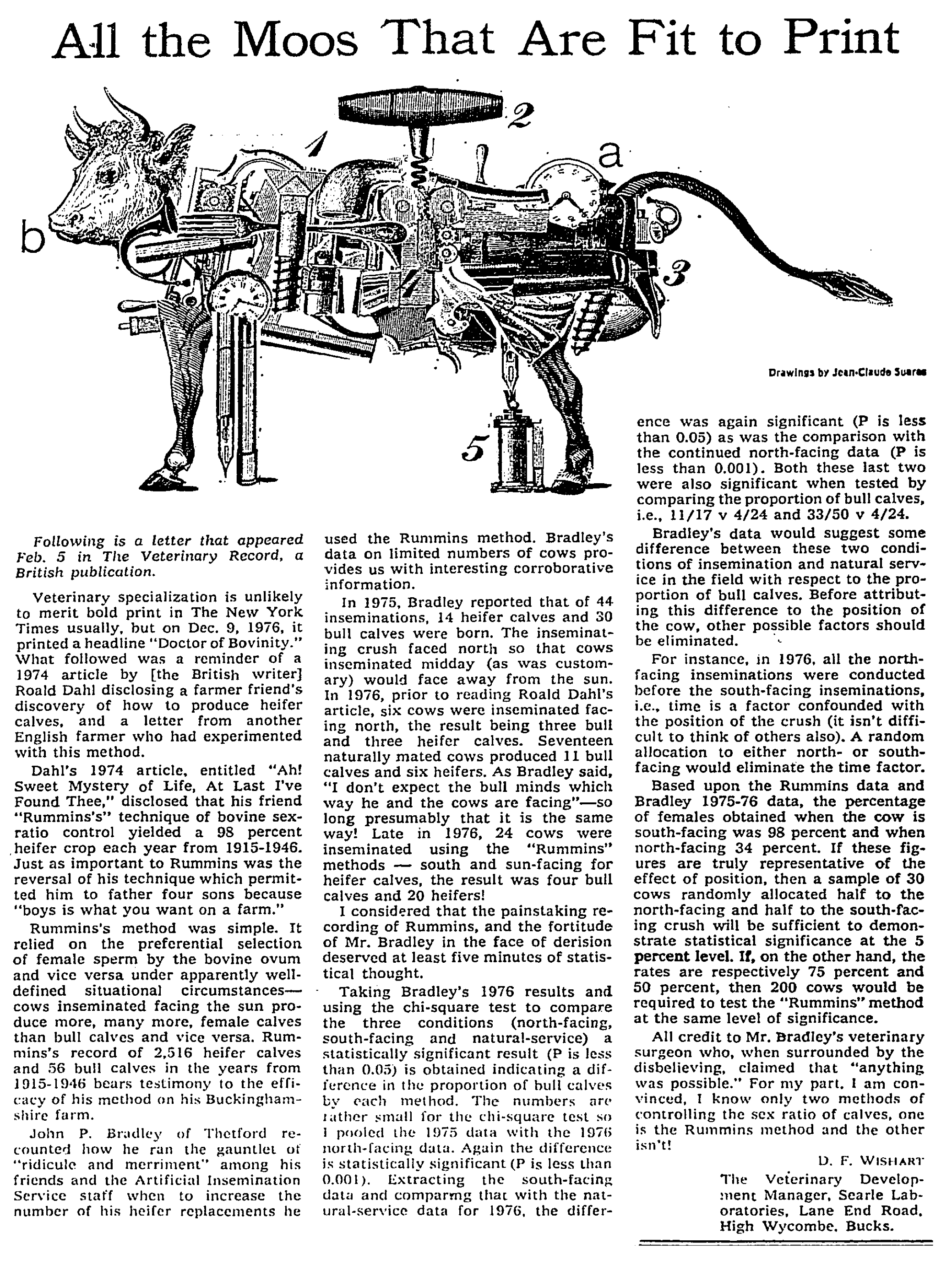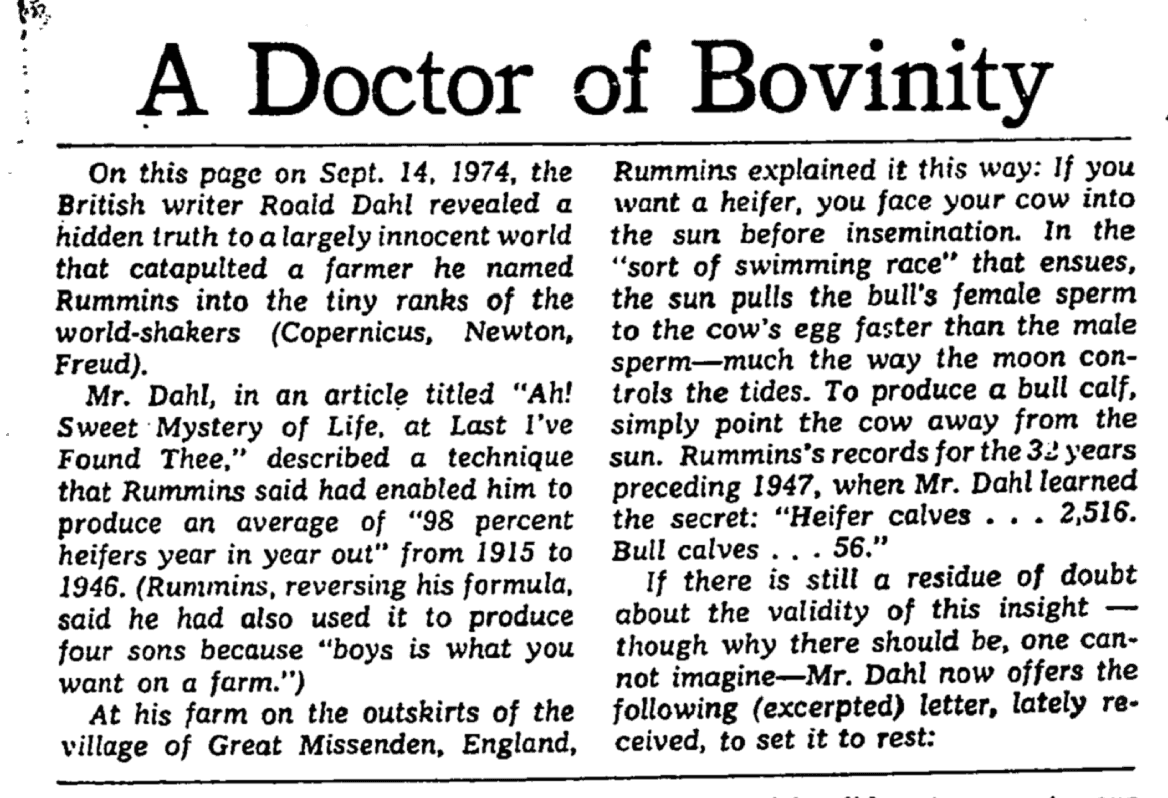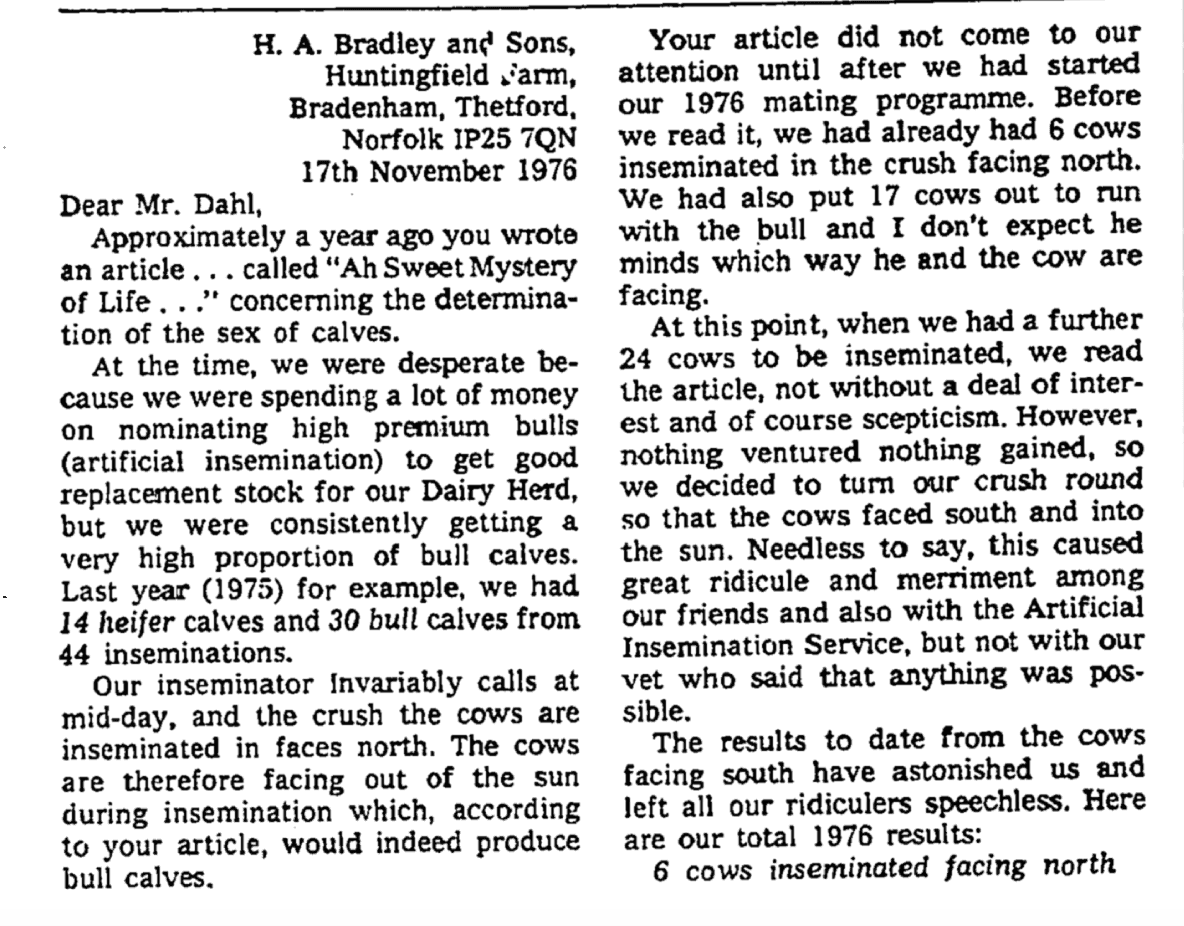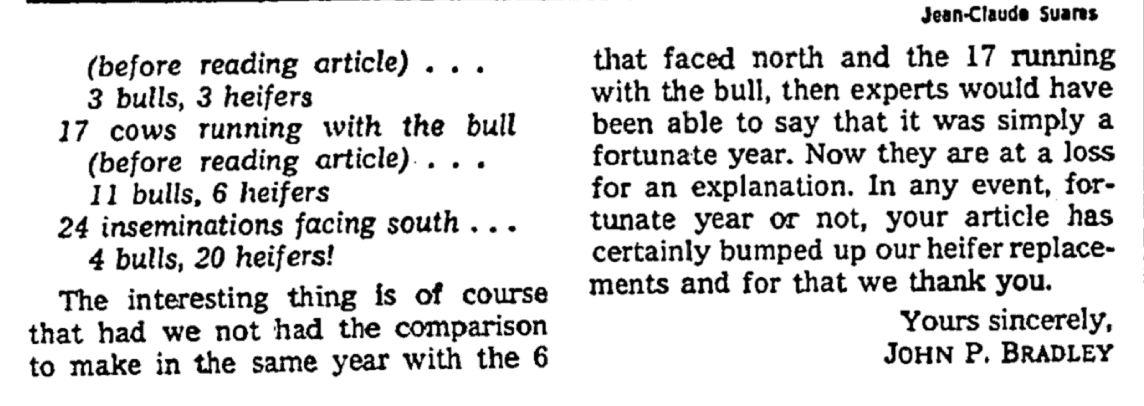This letter was published in Veterinary Record on February 5, 1977.

This letter was published in Veterinary Record on February 5, 1977.

This letter was published in The New York Times on December 9, 1976.



Sections: Information | Introduction | Plot Description | Fun Stuff
Roald Dahl introduces this version of the story as if it happened to him!
The other day, when this newspaper invited me to write a short piece on more or less any subject, I declined. I was struggling with a new children’s book, I said, and I find it difficult to switch over from one thing to another. But I had no sooner replaced the receiver when I began to have second thoughts.
The New York Times, I told myself, is read by just about everybody of consequence in the United States, including the President himself. So what a tremendous opportunity this would be to say something of world-shaking importance and to implant the message directly into the minds of powerful men.
But did I have such a message? Nothing in the lead bit trivial would do. Nothing political or witty or smart-aleck. It must, in fact, be something of major benefit to mankind the world over. Something along the lines of Salk and his polio vaccine or Roentgen with his exposed photographic plate or Fleming with that little bacteria-free circle on the watch glass. Something like that.
Well now, I thought. And I went on thinking and thinking and nothing much happened….until suddenly click went a little trigger somewhere inside the head and I cried out, “I’ve got it!” And indeed I had.
For the last 27 ears I have been stewing and brewing about an incident that took place one misty autumn afternoon in a farmyard on the outskirts of the village of Great Missenden, and I have many times wondered where and when I should make the facts known tot he world. This surely was my chance. So here we go. The story is a true one.
Back in 1947 when there was still a postwar shortage of milk in England, we kept a cow in our orchard. The house I was then living in with my mother and my youngest sister is presently owned by Mr. Harold Wilson, the Prime Minister. So this is the orchard. I mention this for a reason. When my story breaks upon the world, thousands of people will flock to Great Missenden to stand and stare at the house where i tall started. And Mr. Wilson, who is no less of an egomaniac than any other politician, will almost certainly think they have come to look at him. He will probably wave to them from an upstairs window and he may even try to make an electioneering speech. If he does, he will be jeered.
This version is slightly different from the later one published in Ah, Sweet Mystery of Life. Claud doesn’t appear at all, for example, and there’s no description of the bull’s, uh, equipment. Dahl also claims that the story is true and happened to him personally in 1947 in Great Missenden.
Spoiler warning! Dahl’s cow started “bulling” so he took her down the road to be serviced by Rummins’s bull. Rummins explains he has a unique way of conducting an official mating that no one else in the world knows. Pointing the cow into the sun, he says, means that a heifer (female) will result, while pointing her away creates a bull (male). The actual reason has something to do with the pull the sun exerts on “female” sperm. After Dahl checks the records to verify this claim, he asks Rummins if it will work with people. “Of course it’ll work with humans,” he said. “…I’ve got four boys of my own, ain’t I?”
Sections: Information | Plot Description
This is from the “Claud’s Dog” series of stories that were first published in Someone Like You.
Spoiler warning! The narrator Gordon and his friend Claud are exceptionally nervous, because they’re about to pull off the biggest scam of their lives. They’re off to the greyhound racing track with their dog Jackie. Claud knows everything there is to know about greyhound racing, and he’s sure they’ve got a winner. Four months before Claud bought a dog that turned out to be a dead ringer for Jackie, but couldn’t run fast at all. They’ve been running the slow dog at the track for the past eight weeks to make sure that he gets moved into the bottom racing grade. Now they plan on running Jackie and placing all their money on him to win. The only obstacle is Mr. Feasey, who runs the track. He has an incredible memory and is able to spot an imposter dog from a mile away. Once they get to the track, they’re horrified when Mr. Feasey tells them that he doesn’t intend to let them run their “champion” anymore. As a last resort, Claud bets Mr. Feasey a pound that Jackie won’t come in last place. This piques Feasey’s interest, and he inspects the dog closely. Satisfied that it’s the same dog, he accepts the bet and allows Jackie into the first race. While Claud gets Jackie ready and bribes the winder (the man who pulls the rabbit that the dogs chase), Gordon goes down the row of bookies placing bets on Jackie. He stands to win over two thousand pounds. The race begins and Jackie wins easily. Mr. Feasey is furious and tells them that they’re banned from the track in the future. Claud takes Jackie back to the van while Gordon goes to collect their winnings. When he gets there, though, the first bookie won’t pay and says he backed another dog. All the details are in the bookmaker’s book, but he won’t let Gordon see it. None of the other bookies will pay out either. “You’re a thief! A lousy little thief!” Gordon yells. “Well, I never,” says the bookie. “Look who’s talking!” Everyone laughs as Gordon sees Claud waiting for him with a suitcase in hand for the money.
Sections: Information | Plot Description
This story, originally published in Dahl’s book Kiss Kiss, is another of the “country stories” that deals with Claud and his friends in the English countryside. (It’s not considered part of the original “Claud’s Dog” series, though.) The narrative centers on two men and the extraordinary method for poaching pheasants one of them invents. If it sounds familiar, it’s because Dahl later reworked the entire plot (and character names and huge chunks of dialogue) into the children’s book Danny the Champion of the World. That book, in turn, had a portion which was later developed into The BFG. As you can see, Dahl definitely approved of recycling his best ideas.
Spoiler warning! Readers of the earlier “Claud’s Dog” series in Someone Like You will undoubtedly recognize the title character Claud back in action. This time the story begins in media res as Claud and his cohort Gordon prepare 196 raisins to take with them poaching in Hazel’s Wood. Gordon’s idea was to fill the raisins with seconal from sleeping pills and knock the birds unconscious. They manage to get in and out of the wood unscathed, bagging 120 birds and dropping the sacks off in a hired taxi. The next day they wait by their filling station for Bessie Organ, the vicar’s wife, to deliver the birds in a specially constructed baby carriage. Before she gets there, though, the powder begins to wear off and the birds all fly out and settle down on the filling station. Horrified, Claud and Gordon know that Victor Hazel will be appearing soon.
Sections: Information | Plot Description
This is a rather gruesome story from the “Claud’s Dog” collection in Someone Like You.
Spoiler warning! Claud Cubbage is walking his greyhound Jackie (see “Mr. Feasey”) when he meets Rummins, an unpleasant farmer who lives nearby. Claud mentions to Rummins that the Health Officer recently sent out a ratcatcher (see “The Ratcatcher”) to poison the rats that are living in Rummins’ hayrick. Rummins says that he and his son Bert will be over later in the day to fetch in that rick. When they arrive, Claud and the narrator come to watch them work. As Bert is hacking into the hay with a knife, he suddenly begins to hear a grating noise as if the knife were rasping along something solid. Bert is frightened but Rummins shouts at him to keep cutting. The narrator starts to remember the day that he helped build the rick back in June. Ole Jimmy had quarrelled with Rummins over the coming storm, and the men decided to stop working for lunch despite Rummins’ worries for the weather. Ole Jimmy was a local drunk who also worked as a maintenance man for the children’s playground. The kids and the town loved him. Claud and the narrator headed back to the filling station to have some sandwiches, while Ole Jimmy said he wanted to take a nap. When they returned the rick was finished and Ole Jimmy had disappeared, leaving his satchel behind. The narrator asks Rummins where he went, and Rummins hesitates before guessing that he went home. All this comes flooding back to the narrator as he watches Bert struggle to cut through the hard object buried in the hay. The boy finally manages to break through and lifts out the chunk of hay, only to freeze when he sees what is before him. “Rummins, who knew very well what it was, had turned away and was climbing quickly down the other side of the rick. He moved so fast he was through the gate and halfway across the road before Bert started to scream.”
(If you don’t get it, Ole Jimmy was dead inside the hayrick. That’s what the rats were eating and what Bert cut through with the knife.)
Sections: Information | Plot Description
This is one of the “Claud’s Dog” series of stories from Someone Like You and it features many of the same characters from the other tales.
Spoiler warning! The narrator is at the filling station one day with Claud when the ratcatcher sidles up and announces that he has been sent by the Health Officer to take care of the rat problem. He begins to expound on the difficulty of outsmarting rats and the different approaches you would take to killing them. Claud tells him that the rats he needs to kill are living in a hayrick across the road. The ratcatcher, who looks a lot like a large rat, formulates a cunning plan: he will leave oats around the rick for a few days to gain the rats’ trust, and then he’ll spread poisoned oats that will kill them. When he comes back to pick up the dead rats though, he discovers that they haven’t touched the poison. He claims that they must have another food supply from somewhere (there’s a gruesome connection here with “Rummins”) and they’re too full to eat the oats. Disappointed by his failure, he tries to make amends with the men by showing them some rat tricks. He pulls a rat out of his pockets (“Always got a rat or two about me somewhere.”) and drops it down the neck of his shirt. Then he drops in a ferret he pulled out of another pocket. A frantic chase and fight ensue in the shirt, and eventually the ratcatcher pulls out the dead rat and the bloody ferret. After that performance, he claims he can do something even more amazing: he can kill a rat himself without using his hands or arms or legs or feet. He gets Claud to bet him a shilling that he can’t. He produces another live rat and they tie it to a car antenna. The ratcatcher begins to stare at the rat, moving closer and closer, until finally he strikes like a snake with his mouth open and his yellow teeth biting. The narrator closes his eyes, and when he opens them the ratcatcher is collecting his money and spitting out blood. “Penny sticks and licorish bootlaces is all made from rat’s blood,” he claims. When he notices that his audience is no longer interested in him, he walks off in his particular rat-like way, “making almost no noise with his footsteps even on the gravel of the driveway.”
Sections: Information | Plot Description | Teacher Ideas
Spoiler warning! Mr. Cyril Boggis is an antiques dealer in Chelsea, London. He doesn’t have a large shop, but he still manages to make a tidy income each year by buying the most remarkable pieces of furniture at very, very cheap prices and selling them for immense profits. His friends in the trade wonder where he finds such rare items so regularly. It turns out that Mr. Boggis’s scheme is rather simple: he dresses up as a clergyman and visits English farmhouses under the pretenses of writing articles for the Society for the Preservation of Rare Furniture. When he finds something valuable, he makes the person an offer and then sells the item in his shop for twenty times as much. On this particular trip he’s canvassing the county of Buckinghamshire and comes across three locals (Claud, Bert, and Rummins) near a dirty, ramshackle farmhouse. Once he convinces them to let him inside, he is flabbergasted to see a Chippendale Commode standing in the living room. The Commodes were made by the famous 18th-century furniture maker Thomas Chippendale, and only three others were known to be in existence. Boggis nearly faints when he realizes that this piece could fetch up to twenty thousand pounds in an auction. He recovers, though, and mentions that he needs a new set of legs for a table he has at home. The ones on the commode, he says, would just fit. Rummins is doubtful, and so Boggis cons him into thinking that the piece is simply a worthless Victorian reproduction. He finally ends up purchasing the commode for the grand total of twenty pounds. After he leaves to get his car, the three men decide to help him out by cutting the legs off for him. Rummins also speculates that the parson might back out of the deal if he can’t fit the entire piece into his car (he doesn’t know that Boggis has a station wagon), so Claud takes an axe and breaks the commode to pieces. “I’ll tell you one thing,” he says. “That was a bloody good carpenter put this job together and I don’t care what the parson says.” At that moment, Mr. Boggis drives up in his car.
Sections: Information | Plot Description
This is from the “Claud’s Dog” series of stories that were first published in Someone Like You.
Spoiler warning! Claud Cubbage is going to his girlfriend Clarice’s house to be inspected and questioned by her father, Mr. Hoddy. Claud wants to marry Clarice and Mr. Hoddy wants to make sure that he can take care of her. Clarice warns Claud, though, not to mention his plan to win at the greyhound track (see “Mr. Feasey”), because her father hates greyhounds. She tells Claud just to make something up to please her father. Later that night, Claud starts to feel uncomfortable as Mr. Hoddy grills him about his future business plans. Claud explains that he and his friend Gordon, who runs the filling station, have a number of expansion ideas that they’re working on. He tries to leave it at that, but Mr. Hoddy presses him. Finally Claud announces that they’re planning to run a “maggot factory.” They’ll harvest maggots from rotting meat, raise them, and ship them to grateful fisherman all over the world. Claud’s imagination begins to run away from him as he describes the different varieties of maggots they’ll supply, along with the various details of feeding them and keeping them warm in the winter. Mr. Hoddy, of course, cannot believe what he is hearing. He’s a grocer and the thought of his daughter being supported by an income from maggots is disgusting to him. He can finally take no more and rises suddenly, asking Claud to stop and escorting him out the door. “I think it’s time I was getting along,” Claud said. “Goodnight.”
Sections: Information | Plot Description
This is from the “Claud’s Dog” series of stories that were first published in Someone Like You.
Spoiler warning! The narrator Gordon and his friend Claud are exceptionally nervous, because they’re about to pull off the biggest scam of their lives. They’re off to the greyhound racing track with their dog Jackie. Claud knows everything there is to know about greyhound racing, and he’s sure they’ve got a winner. Four months before Claud bought a dog that turned out to be a dead ringer for Jackie, but couldn’t run fast at all. They’ve been running the slow dog at the track for the past eight weeks to make sure that he gets moved into the bottom racing grade. Now they plan on running Jackie and placing all their money on him to win. The only obstacle is Mr. Feasey, who runs the track. He has an incredible memory and is able to spot an imposter dog from a mile away. Once they get to the track, they’re horrified when Mr. Feasey tells them that he doesn’t intend to let them run their “champion” anymore. As a last resort, Claud bets Mr. Feasey a pound that Jackie won’t come in last place. This piques Feasey’s interest, and he inspects the dog closely. Satisfied that it’s the same dog, he accepts the bet and allows Jackie into the first race. While Claud gets Jackie ready and bribes the winder (the man who pulls the rabbit that the dogs chase), Gordon goes down the row of bookies placing bets on Jackie. He stands to win over two thousand pounds. The race begins and Jackie wins easily. Mr. Feasey is furious and tells them that they’re banned from the track in the future. Claud takes Jackie back to the van while Gordon goes to collect their winnings. When he gets there, though, the first bookie won’t pay and says he backed another dog. All the details are in the bookmaker’s book, but he won’t let Gordon see it. None of the other bookies will pay out either. “You’re a thief! A lousy little thief!” Gordon yells. “Well, I never,” says the bookie. “Look who’s talking!” Everyone laughs as Gordon sees Claud waiting for him with a suitcase in hand for the money.